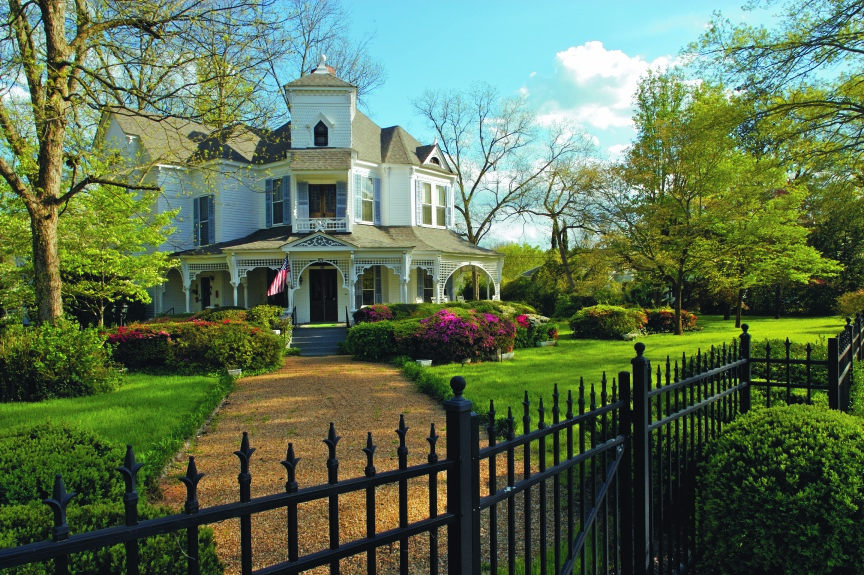
April 2009 | The town of Madison, in Morgan County, Georgia, was lauded in 1849 by the historian George White (1802-1887). “There are as many well educated gentlemen and ladies in Madison as in any portion of the State,” he wrote. “Many of the citizens are wealthy, and live in much style. The ladies are remarkably pretty…and many of them highly accomplished….In point of intelligence, refinement, and hospitality, this town acknowledges no superior.”1
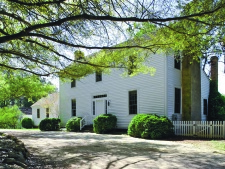
White’s characterization of Madison’s mid-nineteenth-century gentry would hardly apply to the hardy yeoman farmers who had settled what would become Morgan County in the late eighteenth century. Many of them were veterans of the American Revolution who were given land grants in recognition of their military service. Indeed, when Morgan County was surveyed and chartered by an act of the Georgia legislature in 1807, it was named in honor of General Daniel Morgan (1736-1802), under whom some sixty-two of the settlers had served. The farmers were, in effect, also frontiersmen. Between 1802 and 1805 the Creek Indians, under duress, ceded vast tracts of land to the United States. They were understandably enraged at being dispossessed, and the settlers lived in dread of Indian raids.
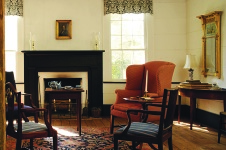
Madison was incorporated as the county seat in 1809, the same year that the eponymous James Madison was inaugurated as the fourth president of the United States. The town, which was on the stagecoach route between rambunctious New Orleans and genteel Charleston, was quickly settled. In April 1810 the Scots traveler and mapmaker John Melish (1771-1822) observed that “Madison, the county-town…was laid out only a year before, yet it is now a thriving place, having a courthouse, a number of dwelling-houses, three taverns, and many stores.”2 At the time of his visit there was widespread fear, not of harassment by the Indians, but of a slave uprising. Melish considered the rumors groundless, writing that “there can never be a successful organization of black people against the whites… [because of the] many ties of affection, which but a small majority among the negroes, I believe, would be willing to break.”3
Madison, which was organized around a central square, is situated on a ridge between Sugar and Hard Labor Creeks in the heart of the Georgia piedmont, a hilly fertile region with the Blue Ridge Mountains to the north and a coastal plain to the southeast. The land was notably well-suited to the cultivation of upland green-seed cotton, but because of the extreme difficulty of separating the cotton boll from the seed, it was not until a series of fortuitous circumstances culminated in the ingenious invention of Eli Whitney (1765-1825) that farmers could profitably plant the crop on a grand scale.
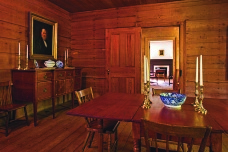
This Massachusetts farm boy with a prodigious talent for mechanics spent the winter and spring of 1793 at Mulberry Grove, a plantation near Savannah. It was there, as he wrote his father in September 1793, that he devised a machine “with which one man will clean ten times as much cotton as he can in any other way.”4 When he wrote his father again in March 1794 he had acquired a workshop in New Haven, Connecticut, and was already manufacturing cotton gins for shipment to Georgia. However, because the machine could be easily duplicated, the profits to Whitney were miniscule. While he had written to his father, “I shall probably gain some honour as well as profit by the Invention,”5 it was the southern planters who were enriched.
In the first decades of the nineteenth century men of substance arrived in Morgan County, acquired thousands of acres, planted them in what came to be known as white gold, and made sizable fortunes. However, contrary to the popular notion of the antebellum South, there were many more modest farms of several hundred acres in the country around Madison than there were great plantations. The farmers built well-crafted, unadorned, durable houses in what is now called the plantation plain style.
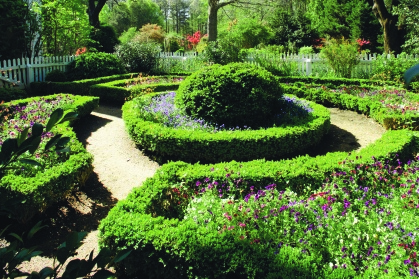
An attractive example is Cedar Lane Farm, built in the 1830s by Henry Hilsabeck, who moved from the Moravian area of North Carolina to Georgia and, in 1812, acquired some two hundred acres in Morgan County. The two-story clapboard house has three bays, with massive chimneys at each end (Fig. 2). The interior walls are sheathed with heart pine, and the mantels are bold versions of the Greek revival style (see Figs. 3, 4). Hilsabeck prospered, and at his death in 1845 he owned five hundred acres. He left the farm jointly to his widow and a cousin. Item five of his will stipulates that:
My son Martin Hilsabeck [b. c. 1817] be supported out of the proceeds of the plantation by my wife and cousin, so long as he shall abstain from the use of spirituous liquors and deport himself as a good and worthy citizen.”6
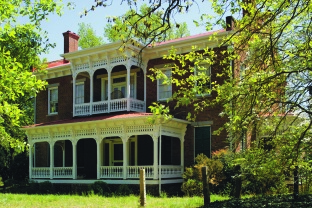
Jane Symmes and her late husband John acquired the house, with two hundred acres, in 1966; and they meticulously restored it and furnished it appropriately. They also created an elegant garden with boxwood planted in concentric circles, a design with antebellum precedents (Fig. 5).
Unlike Hilsabeck, who managed his farm himself, the more affluent planters hired overseers for their plantations; and it was these planters, as well as the doctors, lawyers, and clergymen whose services they required, who built the impressive houses in the town. Most of them were constructed during the three decades from 1830 to 1860 that have been called Madison’s golden years. In the 1830s John Byne Walker built the handsome house known as Bonar Hall (Fig. 6), one of the few brick houses built in Madison before the Civil War. Evidence suggests that there was originally a neoclassical entrance, replaced, probably around 1880, by the large ornamental porch on the first floor and the smaller second-story porch. The brick was made on Walker’s plantation. In subsequent years he supplied the brick for a courthouse, a depot, the Georgia Female College, and the Madison Baptist Church.
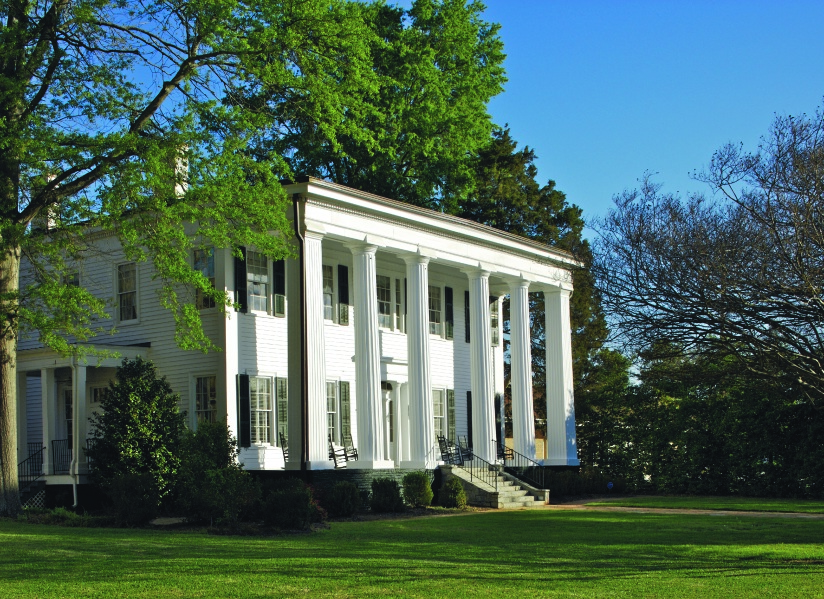
From 1827, when he began farming on land his father gave him, until 1864, Walker kept what he called his plantation book.7 In longhand he recorded births, marriages, illnesses, and deaths as succinctly as he reported the agricultural production of his several plantations. In 1832 he wrote:
August 20th begun to pick Cotton &…made 76 bales average 300 lbs & sold it for 9 ½ & 10 cents/August 29th Married this night E S Fannin at the House of Adam G Saffold Esq/corn plenty & wheat and oats.
His bride, Eliza Saffold Fannin, was an heiress, whose dowry, Bonar noted in the plantation book, included some sixteen hundred acres and fifty-one slaves as well as, among numerous other items, “a side board, 1 clock, 1 Book case, 1 Bureau, a lot of Books…& Stock of chickens Ducks Turkey.”

It is probably the stately Greek revival columnar houses that are considered the most characteristic of antebellum Madison. Two especially handsome examples are the Martin-Weaver house on North Main Street (Fig. 8) and the house now called Heritage Hall on South Main Street (Fig. 7). Owned by Dr. Elijah Evans Jones, who had studied at the medical school at the University of Pennsylvania in Philadelphia and had settled in Madison about 1815, Heritage Hall is one of the most sophisticated houses in Madison. Its main entrance duplicates Plate 15 in Minard Lafever’s Young Builder’s General Instructor (1829).
Hilltop, which faces the Martin-Weaver house, is an attractive plain style house with classical features (Fig. 9) built in the 1830s by Samuel Shields for his daughter Julia (1809-1884) and her second husband, Thomas Jefferson Burney (1801-1876), a prominent lawyer, who were married in 1837. Two stories high and five bays wide, it is only one room deep. The well-proportioned portico was probably added sometime before 1850. Flush boards surround the entrance door while the rest of the house is clapboarded. The juxtaposition of simplicity and formality is most effective.
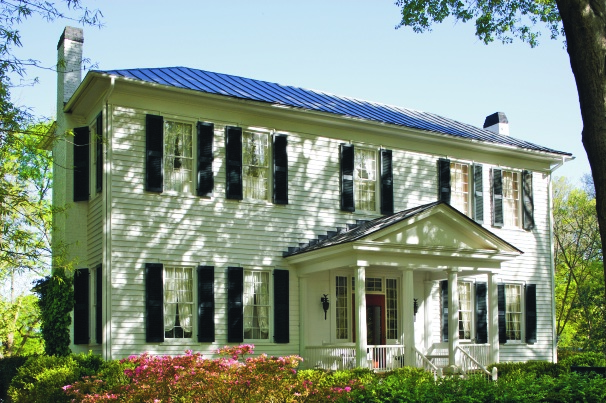
By the 1850s builders were introducing Italianate elements to the designs of many houses. While the structures were generally still two-story, five-bay boxes with classical entrances, now one-story ornamental verandas sometimes replaced the massive columns, and there was a proliferation of decorative brackets beneath the eaves. The house on Dixie Avenue shown in Figure 10 is an excellent example. The journalist Medora Field Perkerson (1892-1960) related a local legend about the house. Until 1866 any property belonging to a woman in Georgia automatically became the possession of her husband. It seems that a lady who inherited the Dixie Avenue house imprudently married a compulsive gambler, and shortly after the wedding he lost the house in a weeklong poker game. According to Perkerson, this deplorable incident “was responsible for the introduction and passage of the Married Woman’s Property Act in Georgia, which made it possible for a wife to own property in her own name.”8
Another remarkable house exhibiting the Italianate influence is Boxwood, built by the planter Wilds B. Kolb in the early 1850s (Figs. 11a, 11b). The two facades are identical except for the entrances, the one facing the Old Post Road having a one-story classical porch and the one on Academy Street with a lacy Italianate veranda. The spaces between the two streets and the respective entrances are adorned with elaborate boxwood parterres that were probably created soon after the house was built.
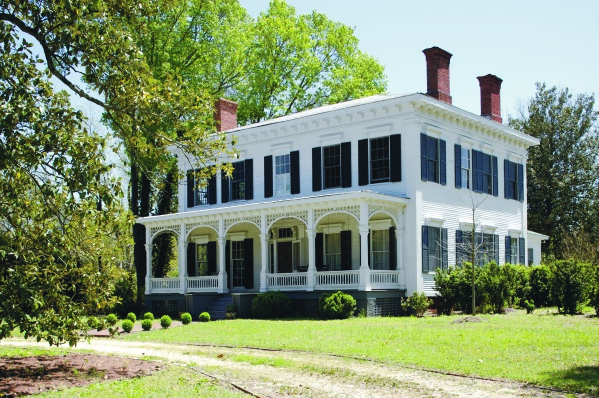
Kolb was one of the wealthiest planters in the Georgia piedmont, and he could afford to furnish his house in lavish fashion. The parlor displayed a suite of rococo revival rosewood furniture upholstered in green and gold brocatelle. The matching draperies had gilt-metal cornices and gilt tiebacks trimmed with green glass flowers.9
From the time Madison was settled, education and religion were major cultural factors. As early as 1818 a male academy was established, and at mid-century both the Baptists and the Methodists founded colleges for women, both of which flourished until the Civil War. The Baptists’ Georgia Female College (founded as Madison Collegiate Institute) occupied two buildings on South Main Street. The smaller one, known as the president’s house, is now a private residence (Fig. 12), while the adjacent brick building burned in the 1880s (see Fig. 13). The impressive variety of courses at the college included philosophy, history, geology, botany, and foreign languages, as well as music, painting, and work with wax fruit and flowers.
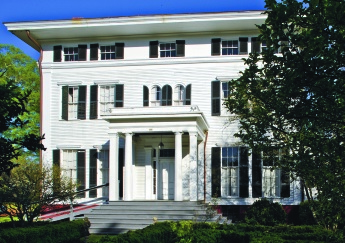
In addition to the Baptists and the Methodists, the principal denominations in antebellum Madison were the Episcopalians and Presbyterians. In 1842 the Presbyterians built a starkly beautiful Greek revival edifice on South Main Street, the work of a skilled mason named Daniel Killian (Fig. 16). The churches in this tightly knit community in the antebellum years were centers of social as well as spiritual activity. Dolly Lunt Lewis (1817-1891), a young widow who taught school in Madison in the late 1840s, was an ardent churchgoer, attending monthly concerts at the Presbyterian church as well as Sabbath school and prayer meetings at both the Methodist and Baptist churches.
In the past generation historians have drastically revised the pretty southern myths, so that the phrase “moonlight and magnolias” has become an epithet. And yet, in Madison there were moonlit picnics at the Male Academy, cotillions and quadrilles at the American Hotel, weeklong house parties, and flirtations in the fragrant gardens and splendid houses. In July 1842 Jane Stokes (b. 1823) wrote to her brother, a college student in Athens, Georgia: “We have had the gayest season lately ever known in Madison. There are no less than eighteen visiting ladies in our place at one time…belles, who flourished here for a while, and then left carrying with them a dozen broken hearts.”10 Sadly the price of this gaiety was slavery. There were certainly planters who realized that slavery was morally indefensible, but for most of them the conviction that their wealth was dependent on slave labor overcame their scruples.
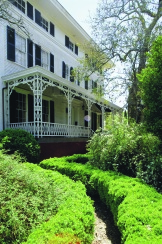
In February 1861 Georgia joined six other southern states in Montgomery, Alabama, to organize the Confederate States of America. The young men of Madison promptly formed the Panola Guards and marched off to war from the grounds of the Georgia Female College wearing sashes made by the young ladies. During the war both women’s colleges were converted into hospitals for the wounded. Many young women volunteered as nurses, cutting up their sheets and tablecloths for bandages and providing the wounded with blankets made from their carpets. They foraged in the woods for plants to be utilized for medicinal purposes: mustard seeds, hickory leaves, and pepper to treat pneumonia, and blackberry root to control dysentery.
There was a minority faction in Madison that opposed secession. Prominent among them was Joshua Hill, a lawyer and member of Congress, who resigned when Georgia seceded. He and John Sherman (1823-1900), a brother of William Tecumseh Sherman (1820-1891), had enjoyed a friendly relationship in Washington. When Hill’s son Legaré (c. 1846-1864), who had joined the Confederate Army against his father’s wishes, was killed in battle in north Georgia, Hill presumed to call on General Sherman in Decatur, near Atlanta, to ask his help in procuring Legaré’s body for burial in Madison. Sherman received him graciously, honored his request, and invited Hill to join him for dinner in the mess. Sherman recorded the meeting in his autobiography:
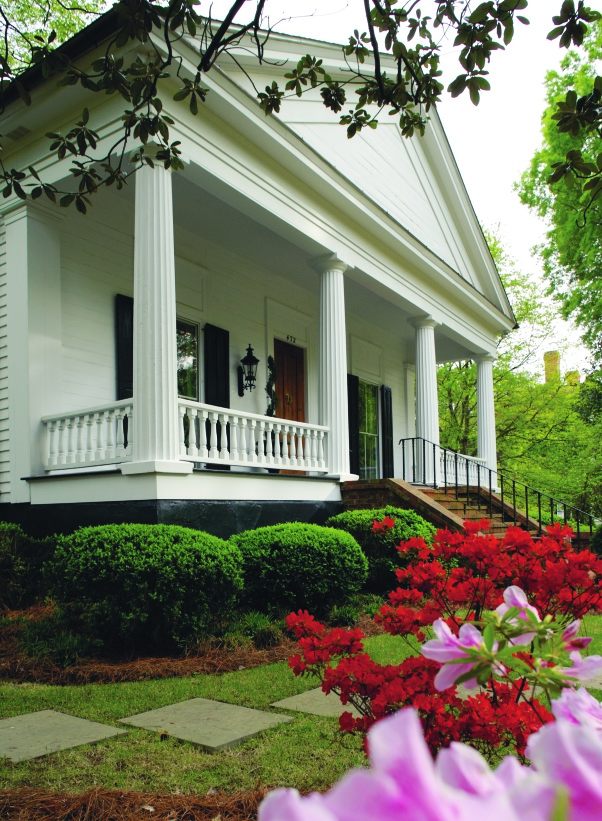
We naturally ran into a general conversation about politics and the devastation and ruin caused by the war….Mr. Hill resided at Madison…and seemed to realize fully the danger; said that further resistance on the part of the South was madness, that he hoped Governor Brown of Georgia would so proclaim it and withdraw his people from the rebellion….I told him, if he saw Governor Brown, to describe to him fully what he had seen and to say that if he remained inert, I would be compelled to go ahead, devastating the State in its whole length and breadth; that there was no adequate force to stop us, etc.; but if he would issue his proclamation withdrawing the State troops from the armies of the Confederacy, I would spare the State…and would, moreover, pay for all the corn and food we needed….I believe that Mr. Hill, after reaching his home in Madison, went to Milledgeville, the capital of the State, and delivered the message to Governor Brown.11
But Brown refused Sherman’s offer, and the notorious march through Georgia ensued.
In letters to his family in Connecticut, written in December 1864 from a camp near Savannah, Rufus Mead Jr. (1836-1922) described the exhilaration he experienced on the march from Atlanta to Madison. “We had a glorious old tramp right [through] the heart of the state, rioted and feasted on the country…in short found a rich and overflowing country filled with cattle hogs sheep & fowls, corn sweet potatoes & syrup but left a barren waste for miles on either side of the road.”12 When the Union troops reached Madison they burned the depot and some commercial properties, and according to Mead, the officers and men were “appointed to see that no cotton, gin, or press is left behind”; but, perhaps due to Joshua Hill’s persuasiveness, none of the houses were destroyed. To his surprise, Mead was charmed by the town. “Passed through Madison. Found it the prettiest village I’ve seen in the state. One garden & yard I never saw excelled even in Connecticut,” he wrote.
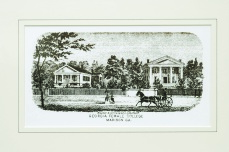
The twelve years of Reconstruction were a difficult time for both white and black citizens of Madison. Exacerbating the town’s postwar problems, a fire in 1869 destroyed much of the commercial district around the central square. In the 1870s most of the businesses and offices were rebuilt in brick, giving downtown Madison a picturesque late Victorian aspect. It was during this period that Joshua Hill bought a commodious house on the Old Post Road (Fig. 14). Popular despite his anti-secessionist convictions, in 1868 he was elected to the United States Senate.
Two striking edifices built in the 1870s and 1880s attest to Madison’s reviving economy (see Figs. 1, 17). With the help of the Freedmen’s Bureau the black congregation of Calvary Baptist Church acquired property previously occupied by the white congregation at the Madison Baptist Church, and about 1873 built a handsome three-bay brick structure with a wooden steeple (Fig. 17). Over the years the church has hosted many revival meetings, the spirit of which are captured in Revival Meeting by the masterful artist Benny Andrews, who grew up on a farm near Madison (Fig. 15).
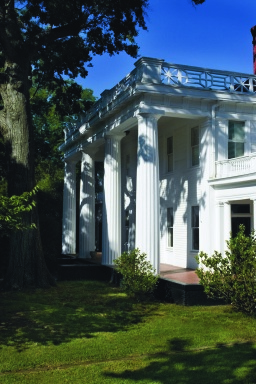
The grandiose Hunter house on South Main Street is a product of Madison’s post-Reconstruction mercantile wealth (Fig. 1). Built about 1883 for John Hudson Hunter, whose fortune accrued from a furniture emporium and a drugstore, it is an example of late nineteenth-century eclecticism at its most flamboyant. The asymmetrical plan accommodates congeries of wings, porches, and gables that protrude in all directions. Hunter was obviously house-proud: his initials are carved on the three round arches on the downstairs porch.
Although the vast seignorial cotton plantations were no longer feasible after the Civil War, cotton was still the principal crop in Morgan County and prices rose steadily. At the turn of the twentieth century Madison was again a flourishing community. Two impressive public buildings were constructed during these palmy years: the Madison Graded School, built on South Main in 1895, exemplified the Romanesque revival; and the monumental neoclassical Morgan County Courthouse was built in 1905 (see Fig. 18).
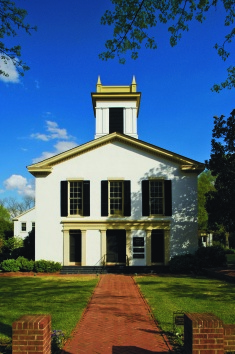
The influx of the boll weevil in the early twentieth century deposed King Cotton more effectively than the Civil War had done, but in the 1940s and 1950s the county again demonstrated its resilience. There was a shift from labor-intensive crops to dairy farming, which was more profitable, and a number of new enterprises provided employment. In recent years Madison has become increasingly protective of its architectural treasures, and many of the early houses have been sensitively restored. The elegant town has attracted collectors of art as well as preservationists. In 1954 Henry D. Green (1909-2003), a scholar as well as a collector, and his wife Mary Frances acquired an 1815 farmhouse near Madison and filled it with an exceptional collection of antique furniture, most notably Georgia pieces.
Today Madison is a cultural hub as well. In 1976 the capacious building that once housed the Madison Graded School reopened as the Madison-Morgan Cultural Center, accommodating a history museum, an art gallery, and an auditorium for musical and theatrical performances. Native son Benny Andrews served on the board and was instrumental in promoting the center.
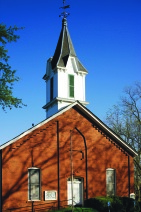
This year Madison celebrates its bicentennial. Shaded by the leafy branches of ancient oak trees, a visitor today strolls where stagecoaches once stopped at the inns and taverns. Contemplating Madison’s two-hundred year history, he savors the beautifully maintained gardens and glorious architecture, walking slowly in order to delay his departure from this gracious old town.
Among the many people in the friendly town of Madison who were helpful to me, I am particularly grateful to the distinguished Madison historian Marshall Williams; Jane Symmes, co-author of Madison, Georgia, an Architectural Guide (1991); and the staffs of the Madison-Morgan Cultural Center, the Morgan County Archives, and the Uncle Remus Regional Library.
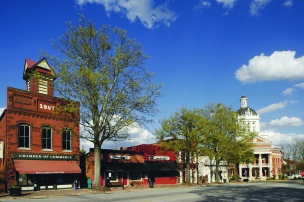
1 George White, Statistics of the State of Georgia (Savannah, 1849), pp. 435, 437. 2 John Melish, Travels in the United States of America, in the Years 1806 and 1807, and 1809, 1810, and 1811 (Philadelphia, 1812), p. 377. 3 Ibid., pp. 378-379. 4 Quoted in Jeannette Mirsky and Allan Nevins, The World of Eli Whitney (Macmillan, New York, 1952), p. 66. 5 Ibid. 6 Henry Hilsabeck’s will is in the probate records in the Morgan County Archives in Madison. 6 Walker’s plantation book is in the collection of a descendant. 7 Medora Field Perkerson, White Columns in Georgia (Rinehart, New York, 1952), p. 55. 8 The furniture and draperies are now on view in the Madison-Morgan Cultural Center in Madison. 9 Quoted in Louise McHenry Hicky, Rambles Through Morgan County (Wilkes Publishing, Washington, Ga., 1971), p. 105. 10 William T. Sherman, Memoirs of General William T. Sherman, 2nd ed. (D. Appleton and Company, New York, 1904), vol. 2, pp. 137-138. 11 The quotations of Rufus Mead Jr. published here are from “With Sherman through Georgia and the Carolinas: Letters of a Federal Soldier,” ed. James A. Padgett, Georgia Historical Quarterly, vol. 33 (March 1949), pp. 55-58.
WILLIAM NATHANIEL BANKS writes and lectures widely about old towns and houses.
